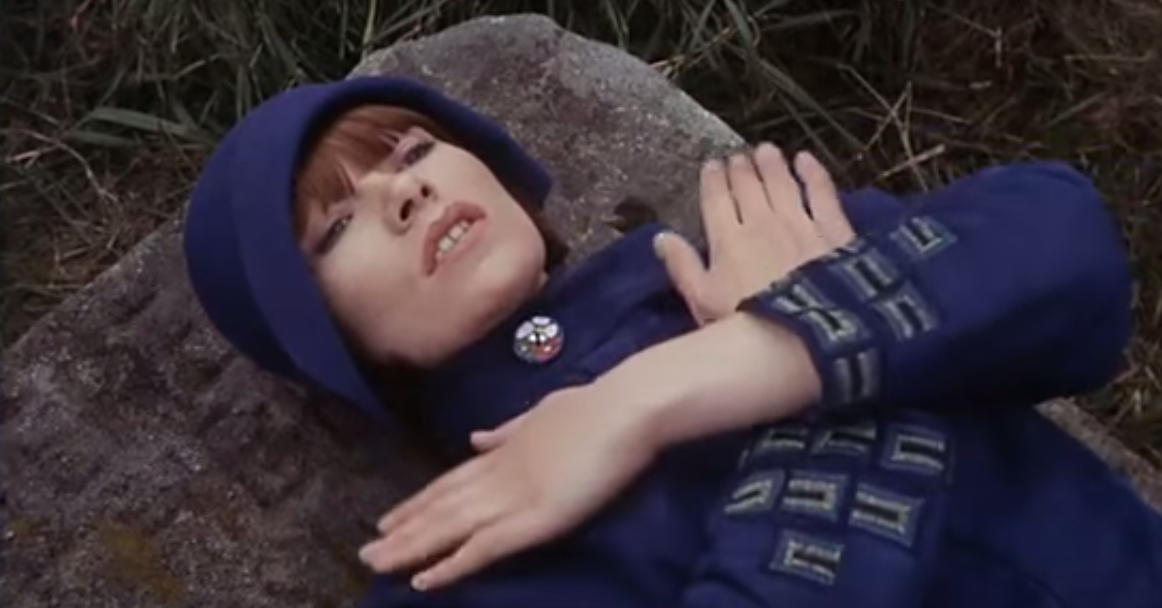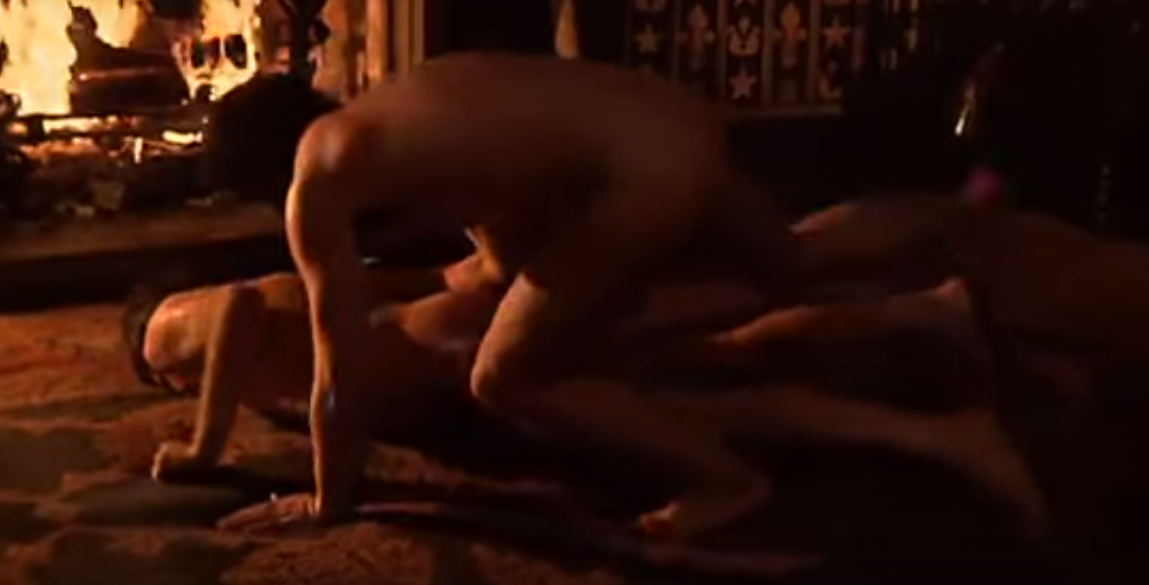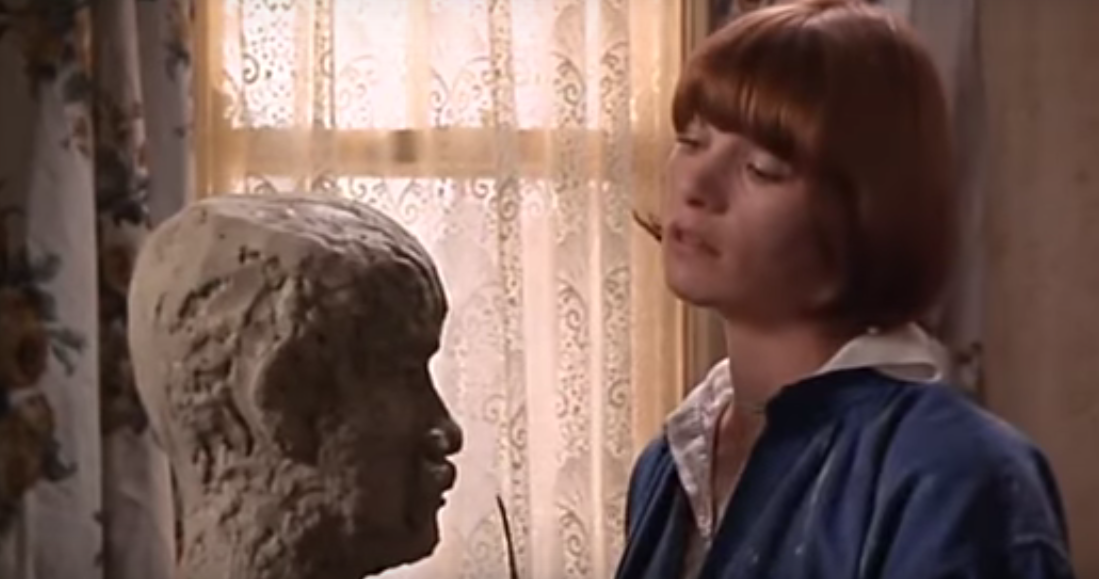THE DECORATIVE LIVES OF WOMEN IN LOVE
Lisa Zeiger
Mr. Brangwyn tools leather in the family's neo-Arts and Crafts house.
Things men have made with wakened hands, and put soft life into
are awake through years with transferred touch, and go on glowing
for long years.
And for this reason, some old things are lovely
warm still with the life of forgotten men who made them.
--D.H. Lawrence
I first saw Ken Russell’s 1969 film Women in Love in 1973 when I was sixteen, soon afterwards reading the D.H. Lawrence novel of 1920 on which it was based. Both movie and book became my manuals for houses, clothes and sexual experiment. For a discomfited L.A. girl, they signaled a densely cultured world I knew would one day suit me better than my vacuous birthplace, spread out like some bimbo grande horizontale. If I could not go back in time, I could go forward in place, and England was the first of several cinematic meccas I would discover as a child and young woman, and live in as an adult.
D.H. Lawrence’s Women in Love is not only a paean to erotic possibility, it is a map of the rich material culture--with presentiments of Modernism--which once enclosed and abetted such encounters, a decorative accompaniment to sex that was a sort of visual soul music for bodies longing to merge. Just as we are still aroused today by the music of Marvin Gaye, so Lawrence’s late Edwardians were drawn towards sexual healing as much through the seduction of beautiful rooms, clothes and objects as by the sexual attributes common to all humans, aesthetes or not. The Gesamtkunstwerk of rooms and their decoration throughout Britain and Europe permitted and evinced a moody eroticism which might, indeed, have been their creators’ most basic impulse in the first place.
Ken Russell’s Women in Love turned British cinema from its early 1960s depictions of the contemporary working classes--shot almost always in stunning black and white--towards a highly colored nostalgia for more extravagant pre-war eras, as well as Day-Glo celebration of late ‘60s Swinging London. The late 1950s and early ‘60s “kitchen sink” dramas had invested the dark grit of hard lives with even darker glamour, a captivating contradiction that has never quite disappeared from British cinema. Russell’s flamboyance was still underpinned by the deeply serious and subtle exploration of emotion in these magnificent films. For all its lush color and period decor, Women in Love is as dark about the limits of love as Darling, as erotically doomed as Room at the Top.
Gudrun Brangwyn, artist, played by Glenda Jackson.
Lawrence exalted the supremacy of the natural man, but he was no primitive. As a writer, like Nietzsche, whom he had read, Lawrence invoked the return of the old gods. He sang the body electric yet was preternaturally attuned to the inanimate, to the designed world which was reaching an apotheosis in the 1910s, the period in which Women in Love is set. In meticulous detail, Lawrence records the beauty of made things, even down to lyrical descriptions of women’s clothing, a literary transvestism which greatly amused the late Angela Carter in her essay on Women in Love, entitled “Lorenzo the Closet Queen”: “...D.H. Lawrence attempts to convince the reader that he D.H.L. has a hotline to a woman’s heart by the extraordinary sympathy he has for her deepest needs, that is, nice stockings, pretty dresses and submission.” Lawrence exults in stockings as passionately as he does in nature, and in fact his descriptions of hosiery, “thick, silk stockings, vermilion, cornflower blue and grey, bought in Paris,” were among my favorite passages as a teenager. Pace Carter, Lawrence hit my hotline. And, if anything, it is the men in Women in Love who submit to the women: for all his implacable sexual ardor, Gerald Crich never quite captures Gudrun’s heart; and Rupert Birkin ruefully compromises his ideal of parallel loves for both man and woman to Ursula’s insistence on herself as his one and only love object. Faute de mieux, Rupert capitulates to her fixed exclusivity.
Rupert Birkin (Alan Bates) and Gerald Crich (Oliver Reed) discuss marriage.
Throughout his short, peripatetic life, Lawrence wandered and moved places with his wife Frieda, in restless search of a place in the sun. He died in 1930, only 45, at the Villa Robermond in Vence. The Lawrences’ travels and longer sojourns encompassed Sicily, Australia, Ceylon, Mexico, and Taos, New Mexico, where Frieda settled after his death and where the author’s ashes reside. They had abandoned Britain in 1919, yet Lawrence toted it with him on their “savage pilgrimage” in the form of novels set in the coal-mining region of the Midlands of his childhood and youth. From memories of this often miserable place of inhumane industry, Lawrence would wrest at least as much beauty, mystery and passion as he drew from more exotic climates and peoples. He wrote his final novel, Lady Chatterley’s Lover, in a villa near Florence, but set it in a town modeled on Eastwood, Nottinghamshire, his birthplace. He could not help but lie back and think of England.
Lawrence would have deeply appreciated director Ken Russell’s faithful rendering of Women in Love. Screenwriter Larry Kramer wove in verbatim much of Lawrence’s dialogue. But Russell was faithful to more than speech, for together with his art director Kenneth Jones, he created a lavish, sensuous, and accurate representation of Lawrence’s detailed descriptions of the diverse but always beautiful strains of English aesthetic life of the period which had penetrated even the provincial Midlands where the plot unfolds, all sumptuously shot in wonderfully ambient Technicolor by cinematographer Billy Williams. Women in Love was brilliantly cast, with Alan Bates as Rupert Birkin, a Lawrentian priest of Eros, Oliver Reed as Gerald Crich, rigid scion of a Midlands coal fortune, Glenda Jackson as the aspiring artist Gudrun Brangwyn, and Jennie Linden as her sister, Ursula, both schoolteachers who long for the wider world, for “experience.”
Rupert and Ursula in his country cottage.
We see Shortlands (filmed at Elvaston Castle) the traditional manor house of the Crich family, owners of a coal mine; Breadalby (filmed at Kedleston Hall), the Georgian country mansion of Hermione Roddice, played with touchy hauteur by Eleanor Bron, an aristocratic anti-heroine based on Lady Ottoline Morrell, and pilloried by Lawrence as overbred archenemy of the “real physical body”; the throwback Arts and Crafts town dwelling of Gudrun’s and Ursula’s parents, their father a handicraft teacher.
Then there is Gudrun’s room in the Brangwyn house, where we see intimations of Cubism in her paintings, her small rarefied chamber separated from the other rooms by only a swinging bead curtain, a peekaboo veil for the private world where she explores her talent and difference. Rupert Birkin lives in a pleasantly humble cottage with an assortment of rustic furniture. In a street market scene, he effuses over an old chair as emblematic of the lost England of craftsmanship, buys the chair, then presses it on a stranger shouting, “I don’t want things.”
Rupert and Ursula purchase an old chair.
Women in Love, by its very title, implies plural modes of relationship, a manifesto for more than one kind of love which Lawrence preached and which Russell puts on daring display, in the famous nude wrestling scene between Alan Bates and Oliver Reed in a library lit only by a fireplace, a fight perilously close to the clinch of consummated love. Bates declares afterward, “We are mentally and spiritually close, therefore that we ought be physically close. It’s more complete...Shall we swear to it one day?” Reed answers, “Wait till I understand it better.” Alienated, immured in himself, Gerald shies away from a brotherhood Bates longs to make “eternal,” seeking in the stony Gudrun an impersonal sexual relief, the only form of connection and catharsis he can permit himself, or, indeed, withstand. "You seem to be reaching at the void, and then you realize you are a void yourself,” he tells Rupert.
Gerald and Rupert wrestle by firelight.
Angela Carter listed female submission as an element of Lawrence’s vision of sexual love. Yet it is Gudrun who holds Gerald in her thrall; just as Ursula overrides Rupert’s utopian longing for a love which would embrace other affinities, with her insistence that her love alone be enough for him, a monolith admitting no other competing affections. Women in Love anatomizes a would-be ideal community, a folie a quatre in which the women, especially Ursula, impose an indomitable archaic need for love as dyad. Of the four, only Gudrun is capable of detachment from monogamy, not through the pursuit of other men, but through her ultimate ability to sublimate sex in the service of art.
Gudrun sculpts a head of Gerald.
At the end, in the sublime, glittering Swiss Alps, Gudrun abandons Gerald’s brutal obsession within a a Nietzschean elevation of thin, pure mountain air, forging in its disorienting heights a sexless alliance with a German homosexual artist who promises her work--Arbeit--instead of love. “I think I shall go to Dresden,” she announces with sangfroid, finding at last her means to “fly away.”
In contrast, Ursula’s rage for possession of Rupert becomes no less implacable than Hermione’s, but comes furled in a more appealing persona, an instinctual capacity for “the real, dark sensual body of life,” in authentic answer to Rupert’s own drive. Ursula’s earthiness wins the day, at a price: Rupert’s rueful sacrifice of an ideal love for a male friend, eternal and irrevocable as the sexual centrifuge he lives out with Ursula. Angela Carter, like many critics, reads Rupert’s/Lawrence’s longing reductively, as suppressed homoeroticism. But I take Lawrence at his word, knowing that even the most absorbing and fixated love always lives with in a wider context of personalities and circumstances which provide breathing space for its survival, competing and disruptive though they may sometimes be.
Gerald traverses the Alps, to sleep and death.
The white, unbounded expanse of Women in Love’s final setting, the menacing sublimity of the Alps, signals each character’s unavoidable existential solitude through which each must make his or her way via different paths and urges. Gerald walks for miles alone in the snow until he falls asleep, and frozen, dies, an ironic echo of Rupert’s earlier speech to Ursula: “I would like to die from our kind of life, reborn with a kind of love that is sleep….”
Gudrun decamps for the European project of a new art that will fracture the aesthetics of the past, in parallel to her break with the psychic organization of her own past, passions and place.
In the final scene, Rupert and Ursula, ensconced once more in his Midlands cottage, still debate a question which has no answer: Rupert’s vision of brotherhood in tandem with marriage, a desire Ursula pronounces to be “a perversity.” “You can’t have two kinds of love; why should you?”she asks.
“It seems as if I can’t, yet I wanted it,” he answers.’’
“You can’t have it because it’s impossible,” says Ursula.
Rupert’s reply leaves this enmeshed, embroidered drama and dilemma with four words that hover as a pregnant anticlimax, an enigma: “I don’t believe that.” There, very abruptly, the movie ends, with neither whimper or bang, but with an idea that will resurface, sometimes as secret psychosocial crisis, throughout the external traumas of the twentieth century. Who is our neighbor; may we have allegiances beyond the tiny fortress of the nuclear family? Lawrence’s expansive definition of love as multiple and liberating is as threatening today to the orders--familial, political, national--we cleave to even in their chaos.









